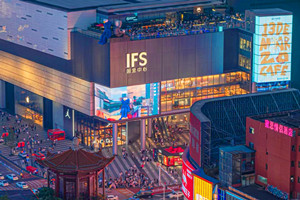 Changsha
Changsha
Changsha is a city that enjoys both modern skyscrapers and ancient streets. It offers not only spicy and delicious cuisine but also serene and profound historical heritages. The Orange Isle carries the memories of the great man, while the thousand-year-old Yuelu Academy whispers the aspirations of scholars. The poetic charm of Aiwan Pavilion is fascinating, and the artifacts excavated from the Mawangdui Han Dynasty Tombs at the Hunan Museum narrate vivid and colorful historical stories. These attractions allow you to delve into the past of Changsha and connect with its soul. Besides these must-visit sites, wandering through the streets and alleys of Changsha, where urban bustle meets profound culture, is also a wonderful choice. Now, let us guide you through these streets and alleys to experience the unique culture of Changsha.
Wenheyou
 Wenheyou
Wenheyou
Visiting Changsha without a stop at Wenheyou would be as regrettable as not visiting Orange Isle or the Hunan Museum. Unlike other commercialized modern districts, this food plaza recreates the streetscapes of old Changsha in the 1980s. Entering Wenheyou is like stepping into the old Changsha of the last century, with three-dimensional and surreal spatial designs and various restored scenes that immerse you in the nostalgic 1980s. Here, you can not only taste Changsha cuisine like stinky tofu, but also admire the unique architecture of old Changsha or purchase one or two distinctive souvenirs to bring back for your family and friends. The old-fashioned cable cars glide slowly through the air, while pedestrians wander through narrow alleys, evoking wonderful memories that make you forget about time and space, capturing countless happy moments. Whether you are familiar with Changsha or not, Wenheyou will always evoke your childhood memories and longing for home.
Huangxing Road Pedestrian Street
 Huangxing Road Pedestrian Street
Huangxing Road Pedestrian Street
The place that best embodies the bustle and prosperity of Changsha is undoubtedly the Huangxing Road Pedestrian Street. Located at the intersection of Tianxin District and Furong District in Changsha City, this street is the heart of the metropolis, spanning over 800 meters in length. Besides a wide variety of clothing stores, accessory shops, and entertainment venues, this street also gathers specialty snacks from all over the country, resembling a culinary palace with all flavors. Every bite of food is a feast for the taste buds, leaving you captivated and unable to resist. As night falls, the street is illuminated with bright lights, and the crowds surge. The street is filled with laughter, cheers, and singing, creating a festive atmosphere. It is Changsha's "city that never sleeps". Stepping into the Huangxing Road Pedestrian Street is like entering a colorful dream, leaving one deeply immersed.
Taiping Old Street
 Taiping Old Street
Taiping Old Street
The Taiping Old Street, originally known as Taiping Street, signifies universal peace and prosperity. It is the most intact street in Changsha's ancient city that retains its original street and alley layout, comprising one main street and ten alleys. The main street, with a total length of 380 meters and a width of about 7 meters, is located in the core urban area of Changsha, exhibiting a fishbone-like layout. The old street has commercial relics such as Qianyisheng Grain Depot and Lisheng Salt Shop, as well as leisure and cultural landmarks like Yichun Garden Theater and Dongtingchun Teahouse. This narrow alley has recorded the development and changes of Changsha city. Nowadays, it not only offers us a sense of historical depth, but also gathers trendy elements in the cultural and creative market, making the old street full of vitality. It is a very inclusive place where elegant art salons coexist with chess and mahjong clubs. Here, you can experience the interweaving of millennial history, culture, and prosperous commerce.
Pozi Street
 Pozi Street
Pozi Street
Pozi Street, an old street that carries with it the historical and cultural memories of Changsha, boasting a history spanning over 1,200 years. Speaking of Pozi Street, you cannot fail to mention the Fire God Palace, which has a history of over 200 years. Here, not only is it a superb destination to sample the delicious cuisine of Changsha, but it is also a great place to immerse yourself in the folk culture of the city. Furthermore, you can wander through traditional shops rich in cultural heritage, admire exquisite handicrafts, and appreciate the wisdom and creativity of the people of Changsha.
Changsha International Financial Center
 Changsha International Financial Center
Changsha International Financial Center
The Changsha International Financial Center (abbreviated as Changsha IFS), standing at a towering height of 452 meters, is the tallest building in Changsha. It is a supertall urban complex that integrates a large shopping and entertainment center, high-end office buildings, serviced apartments, and international platinum five-star hotels. From the restaurant inside the Financial Center, you can clearly enjoy a panoramic view of Changsha City through the large glass windows. The Orange Isle is like a giant ship resting quietly in the Xiangjiang River; the Orange Isle Bridge spans over the Xiangjiang River; and in the distance, the Yuelu Mountain stands by the riverbank, resembling a small hill in front of the tallest point of the city, the International Financial Center. The bustling Wuyi Road, the surrounding skyscrapers, and the pedestrian streets filled with people all demonstrate the rapid development of Changsha. Come to the International Financial Center to experience the prosperity and charm of Changsha!
Tianxin Pavilion
 Tianxin Pavilion
Tianxin Pavilion
Tianxin Pavilion stands on the ancient city wall at the southeast corner of the downtown area, where Chengnan Road intersects with Tianxin Road. It was originally built during the Qing Dynasty. Named after its alignment with the "Changsha Star" in the sky, this Pavilion was once a place where the ancients observed astronomical phenomena and worshipped the gods. Additionally, due to its lofty location, it was considered a Feng Shui Auspicious Site representing good fortune, drawing numerous pilgrims who wished to pray for blessings, disaster relief, and prosperity for their families. Here, lush ivy covers the mottled walls of the city ramparts, while sunlight filters down on the ancient bricks and fresh green vines, creating a serene atmosphere that whispers the vicissitudes of life.
Due to its high elevation and strategic importance, Tianxin Pavilion became a crucial position for both defense and attack, attracting the attention of military strategists. During the Taiping Rebellion, when the Western King Xiao Chaogui led his troops to enter Changsha, they attacked from this very spot. To this day, you can still find cannon holes left on the city wall. During the Anti-Japanese War, in 1938, the "Wenxi Fire" reduced the ancient city of Changsha to a wasteland, and the pavilion itself was completely destroyed, leaving only the solid Ming and Qing Dynasty city wall to silently weep. The Tianxin Pavilion we see today was rebuilt in 1984 on this historical site. It is not only a gate tower and landmark of the ancient Changsha city, but also a witness to the historical development and changes of Changsha.
Tianxin Pavilion Travel Information
Location: Tianxin Road, Tianxin District, Changsha City
Open hours:
(October 1st -- June 30th) 8:00am--17:00pm (last entry at 16:30)
(July 1st -- September 30th) 8:00am--17:30pm (last entry at 17:00)
Recommended visiting hours: 1-2 Hours
Admission: RMB 30




































